Unit 6 Opportunity: SDG10
Reduced Inequalities
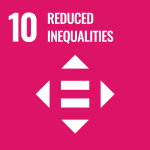
Goal no. 10 of the 2030 Agenda for Sustainable Development aims to reduce inequality within and among countries.
Click on the arrows to reveal more information about SDG10. You don’t need to remember everything you read – the main thing is to get an overview of this Goal.
Information and targets reproduced under the terms and conditions of United Nations websites. Copyright (2023).
A reminder that links in this e-book do not open in a new tab. If you click on any of the links to a webpage, click the back button in your browser to return here.
Key vocabulary
Check that you know the meaning and the whole word family of these key words before you begin the Unit. (NB there may be other versions of the word forms – these are the common forms in the context of SDG 10). Also notice some common collocations in bold in the ‘Why this goal? and ‘Targets’ sections above. Add any new words, word families or collocations that you would like to remember to your vocabulary book.
Verb Noun Adjective
To be equal to equality/equity/equal equal
To give (someone) an opportunity opportunity/opportunism opportunistic
To receive an income income incomeless
Easily confused words – Equality and equity
- Equality refers to the state of being equal, especially in having the same rights, status, and opportunities.
- Equity refers to a fair and reasonable way of behaving towards people, so that everyone is treated in the same way.
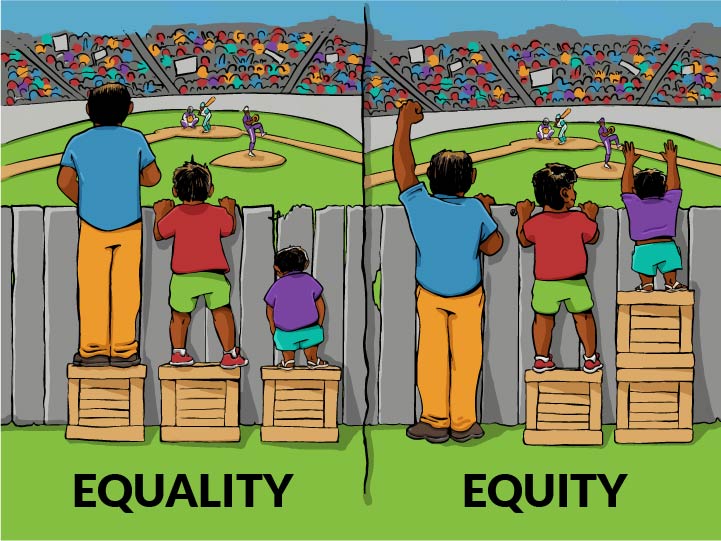
Data visualisation – The world’s wealth inequality
In Unit 5 you considered gender inequality and the ways gender can restrict the life opportunities for some. Inequalities can also be related to income, age, disability, race, ethnicity, origin, sexual orientation, religion or economic status.
- Have you witnessed any of the above inequalities in action?
- Income inequality is on the rise. Both halves of this graphic (2017) represent an equal amount of global wealth. The top half consists of the world’s eight richest billionaires. The bottom half represents the poorest half of humanity – 3.6 billion people.
-
- Do you recognise any of these men or know how they accumulated so much wealth?
- What is your view of individuals owning so much of the world’s wealth?
- What effect does this huge wealth inequality have on life opportunities for the poorest 50%?
- Since 2017 other billionaires have joined this list. Can you name any of them?
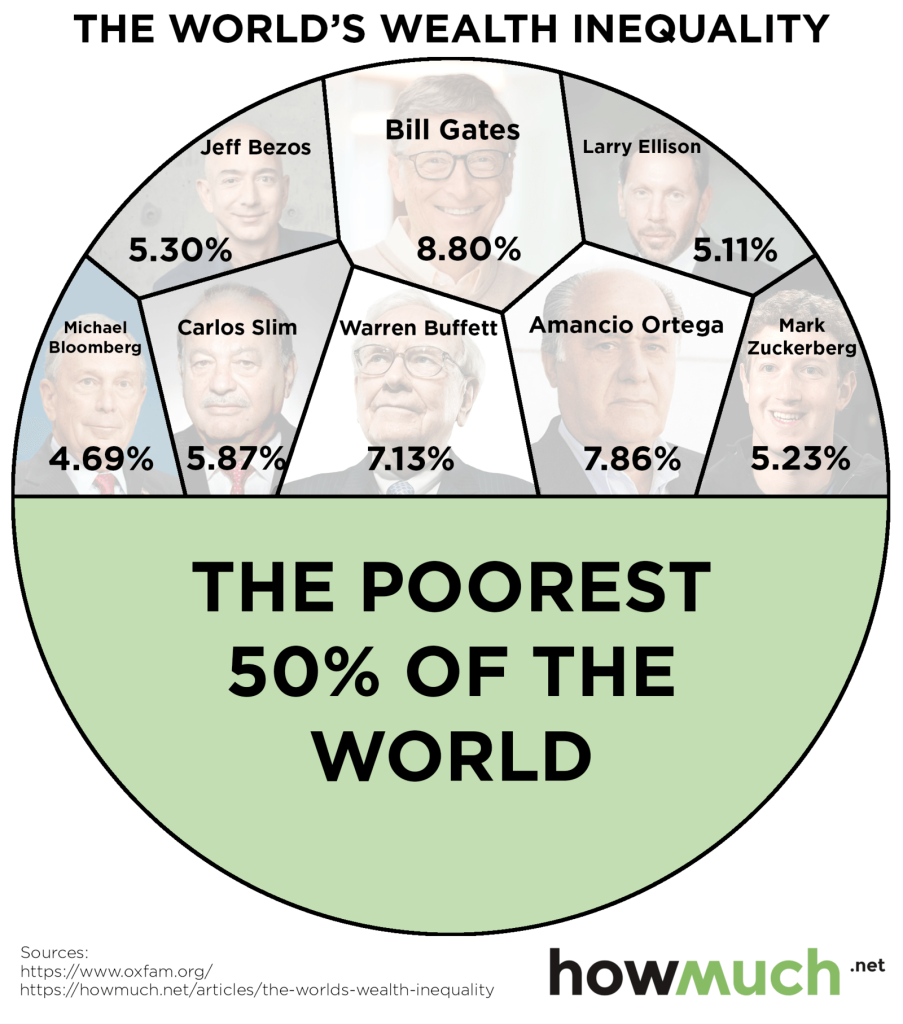
Download the transcript here: Unit 6 Infographic transcript
In your local context…
According to a report by the World Bank in 2019 ‘For every $1 of aid that developing countries receive, they lose $24 in net outflows. Most of the outflows represent the illicit flow of capital from the global South to the North as a result of the use of tax havens or the reporting of false prices on trade invoices.’
Do you recognise this as a problem in your context? If yes, what are the effects? If no, what’s your view of wealthy individuals using tax havens and illicit means to divert aid from the people who need it?
Reading – What I learned when I recreated the famous ‘doll test’ that looked at how Black kids see race
Before you read
You’ve considered gender inequality and income inequality. An experiment in the 1940’s looked at race inequality. The social psychologists Kenneth and Mamie Clark devised a test to study children’s attitudes toward race and their self-image and to see whether African American children were psychologically and emotionally damaged by attending segregated (all-black) schools. During the experiment Clark showed children between the ages of six and nine two dolls that were exactly the same, except that one was black and one was white. They asked the children a series of questions about the dolls:
Which doll is the black doll? Which one is the white doll? Which doll is the pretty doll? Which doll is the nice doll? Which doll is the bad doll? Which doll is the ugly doll? Which doll looks most like you?
1. Can you predict how the children answered the questions? Watch the video (1 min) or read the transcript below and see if your predictions were accurate.
Transcript
- Which doll is the black doll? (Girl points at the black doll).
- And which one is the white doll? (Girl points at the white doll).
- Which doll is the pretty doll? (Girl points at the white doll).
- Which the doll is the nice doll? (Girl points at the white doll).
- Which doll is the bad doll? (Girl points at the black doll).
- Which doll is the nice doll? (Boy points at the white doll).
- Which doll is the bad doll? (Boy points at the black doll).
- Why is that doll pretty? (Because she’s white).
- Which doll is the ugly doll? (Boy points at the black doll).
- Why is that doll ugly? (Because he’s black).
- Which doll looks most like you? (Boy points at the black doll).
2. Which doll do the children ascribe good characteristics to?
3. Which doll do the children ascribe bad characteristics to?
4. What conclusions could you draw from this experiment?
Skim read
In the Clark experiment children in segregated primary schools in the 1950s viewed their racial identity in a negative light. This text is by an academic who recreated the ‘doll test’ in 2017 with her daughter who was in an integrated school. Do you expect the results of her experiment to be similar or dissimilar?
Skim read the introduction (max 2 mins) and see if you were right.
Read for main ideas
- Which word(s) in each sentence helped you identify the paragraph the sentence belonged to?
- Was it a word/phrase/structure that helped you decide, or was it the idea contained in the sentence?
What I learned when I recreated the famous ‘doll test’ that looked at how Black kids see race
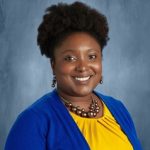
Introduction
Back in the 1940s, Kenneth and Mamie Clark – a husband-and-wife team of psychology researchers – used dolls to investigate how young Black children viewed their racial identities.
They found that given a choice between Black dolls and white dolls, most Black children preferred to play with white dolls. They ascribed positive characteristics to the white dolls but negative characteristics to the Black ones. Then, upon being asked to describe the doll that looked most like them, some of the children became “emotionally upset at having to identify with the doll that they had rejected.”
The Clarks concluded that Black children – as a result of living in a racist society – had come to see themselves in a negative light.
I first heard about the Clarks’ doll experiment with preschool children during a Black studies class in college in the early 2000s. But it wasn’t until one of my daughters came home from preschool one day in 2017 talking about how she didn’t like being Black that I decided to create the doll test anew.
Struggling with identity
When my daughter attended a diverse preschool, there weren’t any issues. But when she switched over to a virtually all-white preschool, my daughter started saying she didn’t like her dark skin. I tried to assuage her negative feelings about the skin she was in. I told her, “I like it.” She just quipped, “You can have it.” But it wasn’t just her skin color she had a problem with. She told me she also wanted blue eyes “like the other kids” at her school.
Perturbed, I spoke with others about the episode. I began to suspect that if my daughter had identity issues despite being raised by a culturally aware Black mom like me – an educator at that – then countless other Black children throughout America were probably experiencing some sort of internalized self-hatred as well.
In search of the cause
The Clarks’ research was used in the 1954 landmark Brown v. Board of Education case to advance the cause of integrated schools. Their findings about Black children’s negative view of themselves were attributed to the effects of segregation. But I knew from experience that the preference for whiteness that the Clarks found was not limited to just Black kids in segregated schools in the 20th century. It was affecting Black kids in integrated schools in the 21st century as well.
Maybe, I thought, the racial bias wasn’t related to schools as much as it was to the broader society in which we live. Maybe it was much more nuanced than whether Black kids attended an all-Black school or went to school alongside other kids.
But to verify that Black kids were still viewing their Blackness in a negative light the way the Clarks found that they were back in the 1940s, I would have to do so as a researcher. So I set out to get my doctorate in early childhood education and began to look deeper into how children develop racial identities.
A new approach
In their doll test studies, the Clarks prompted young children to respond to questions of character. They would ask questions like, which doll – the Black one or the white one – was the nice doll? This required the children to select a doll to answer the question. This experiment – and prior research by the Clarks – showed that young children notice race and that they have racial preferences.
While these studies let us know that – contrary to what some people may think – children do, in fact, see color, the tests were far from perfect. Although I respect the Clarks for what they contributed to society’s understanding of how Black children see race, I believe their doll tests were really kind of unnatural – and, I would even argue, quite stressful. What if, for instance, the children were not forced to choose between one doll or the other, but could choose dolls on their own without any adults prodding them? And what if there were more races and ethnicities available from which to choose?
With these questions in mind, I placed four racially diverse dolls (white, Latina, Black with lighter skin, and Black with medium skin) in a diverse preschool classroom and observed Black preschool girls as they played for one semester. My work was published in Early Childhood Education, a peer-reviewed journal.
I felt choosing to watch the children play – rather than sitting them down to be interviewed – would allow me to examine their preferences more deeply. I wanted to get at how they actually behaved with the dolls – not just what they said about the dolls.
Observing play in action
Without asking specific questions as the Clarks did, I still found a great deal of bias in how the girls treated the dolls. The girls rarely chose the Black dolls during play. On the rare occasions that the girls chose the Black dolls, they mistreated them. One time a Black girl put the doll in a pot and pretended to cook the doll. That’s not something the girls did with the dolls that weren’t Black.
When it came time to do either of the Black dolls’ hair, the girls would pretend to be hairstylists and say, “I can’t do that doll’s hair. It’s too big,” or, “It’s too curly.” But they did the hair for the dolls of other ethnicities. While they preferred to style the Latina doll’s straight hair, they were also happy to style the slightly crimped hair of the white doll as well.
The children were more likely to step over or even step on the Black dolls to get to other toys. But that didn’t happen with the other dolls.
What it means
Back in the 1950s, the NAACP, the nation’s oldest civil rights organization, used the Clarks’ doll test research as evidence for the need to desegregate schools. Yet in my own doll test study, more than half a century later in an integrated setting, I found the same anti-Black bias was still there.
Children are constantly developing their ideas about race, and schools serve as just one context for racial learning. I believe adults who care about the way Black children see themselves should create more empowering learning environments for Black children.
Whether it be in the aisles of the beauty section of a grocery store, the main characters selected for a children’s movie or the conversations parents have at the dinner table, Black children need spaces that tell them they are perfect just the way they are.
NB This version of the article, with permission from the author, does not include the hyperlinks to supporting articles found in the original. Click the title for the full version of the text, published under a CC BY ND licence in The Conversation, which should be used for reference and sharing.
What do you think?
- What do you think about the fact that black primary-school-aged children had developed a preference for whiteness?
- The results of the ‘doll test’ were instrumental in the decision to de-segregate schools in America. What do you think of the idea of segregated schools? What beliefs do you think underpin the creation of such schools? Which people do you think are in favour of segregation?
Grammar – Double comparatives ‘as … as’ and ‘the … the’
Read the four sentences from the text and notice the structures in bold that demonstrate equal or unequal comparisons:
- The children did not find the black dolls as attractive as the white dolls.
- The level of bias the children showed the black dolls was almost as high as in the original doll test.
- The children’s response to the black dolls was nowhere near as positive as their response to the white doll.
- The more black children see themselves reflected positively in the media, the more likely they are to develop a positive self-image.
Double comparatives ‘as … as’ and ‘the… the’
- We use ‘as … as’ with an adjective to make an equal or unequal comparison:
- e.g. The children did not find the black doll as attractive as the white doll.
- We use ‘as … as’ to compare equal quantities:
- e.g. The level of bias the children showed the black dolls was almost as high as in the original doll test.
- We can modify ‘as … as’ with adverbs such as ‘nowhere near’. If the difference between the two items is only slight, we can use ‘almost’, ‘nearly’ or ‘not quite’:
- e.g. The children’s response to the black dolls was nowhere near as positive as their response to the white doll.
- We use ‘the… the’ to show proportionate increase or decrease: the + comparative expression + subject + verb:
- e.g. The more Black children see themselves reflected positively in the media, the more likely they are to develop a positive self-image.
Practice
Complete the double comparative structures with appropriate information:
- The world’s eight richest billionaires own as much… as…
- The more the world’s wealth is concentrated into the hands of a few men the more…
- The more we examine our own biases the more…
- SDG10 aims to reduce inequalities so that people everywhere have as many… as…
- People in developing countries have nowhere near as many… as…
Listening – India Tomorrow part 4: women and gender (8 mins)
![]()
Credit: India Tomorrow 4. Annabel Bligh, host of The Anthill podcast. Licence: CC BY ND

Before you listen – Vocabulary associated with social groupings
In this podcast Annabel Bligh interviews academics Carole Spary, Indrajit Roy and Sneha Krishnan about women members of India’s parliament, the Lok Sabha.
- In Unit 5 you learned about the way gender can affect a person’s life chances. In this listening you’ll hear about the way both gender and caste affect opportunities available to women in the Lok Sabha (the Indian parliament). Match these key terms to their correct definition.
2. Look at the word cloud created from the transcript. The most frequently used words (the biggest ones in the cloud) are: women (33), politics (14), know (10), Dalit (10), politicians (7). With the title in mind (’Women and gender’) create a sentence that uses as many of these words as possible that predicts the main point of the listening.
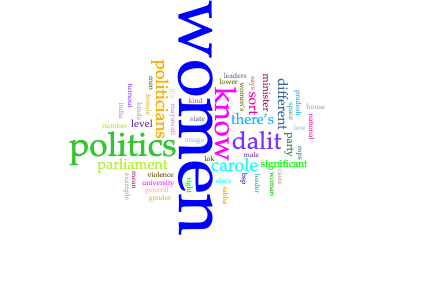
Listen for detail
Play the audio here.
(Or access The Conversation podcast and listen from 18.33mins to 26.34 mins).
- Before you listen, read the summary below. When you have finished reading, listen to the podcast.
- Listen and identify a word or statistic to complete the gaps. Because this is a summary of the podcast and not the whole transcript you need to listen and select a relevant word or statistic from the flow of information while at the same time reading ahead, as some of the detail will, of course, be absent from the summary.
Download the transcript here: Unit 6 Listening transcript
Writing
In this Unit you’ve learned about different types of inequality and how they impact people’s life chances. Fatime’s story of her struggle to survive highlights the inequalities faced by many refugees.
Read Fatime’s story and write a response to it that incorporates what you know about opportunities and life chances as they relate to SDG10 Reduced Inequality. Write about:
- Fatime’s life as a refugee.
- The inequalities that refugees face and the impact on the opportunities available to them.
- The difference between surviving and thriving.
- Any other topic relevant to life chances and SDG10.
A Tent Is not a Place to Call Home
For Fatime, life is an inescapable nightmare. Since fleeing from Syria to Jordan in 2012, her family of eight has been living in one of the many small tents forming a temporary settlement. With the influx of population, her husband has had a hard time finding a job and they depend on 23 JOD per person, per month of assistance from the WFP, surviving on the bare minimum.
More than 80 per cent of refugee families are living in communities that are either food insecure or at risk of becoming so. In light of the ongoing impact of the pandemic on the socio-economic situation of refugees, most families rely heavily on WFP assistance and turn to negative coping strategies such as restricting adult consumption to feed children more, early marriage, or taking illegal jobs to survive. “Life in a tent is not a life,” says Karema, one of Fatime’s neighbours. It is a quote shared by so many people living in these shelters surrounded by snow and cold. Karema talked about how her brother’s child, Abdulla, had sneaked out to play in the snow but returned a few minutes later, soaking wet and cold, barely feeling the heat from the fire. He leaned against the fire pit stove, which was used to heat their tent with branches collected from nearby trees, leaving pieces of his burnt skin on the stove.
“What we’re going through isn’t right, neither for us nor for the children. The international community must come together to help us and recognize our existence. Life has brought us here, and there is nowhere else for us to go. We need all the help and support we can get to help us survive.” Karema stated.
Department of Economic & Social Affairs Statistics Division (2022) ‘Bringing Data to Life: SDG impact stories from across the globe.’ Available at: https://unstats.un.org/sdgs/report/2022/SDG2022_Flipbook_final.pdf
Speaking
- Think about the various inequalities you’ve learned about and discuss the questions:
- Income inequality is on the rise. Do you think that some people deserve to be wealthy, either through inherited wealth or hard work, or do you think wealth should be more evenly distributed in society?
- You’ve heard about the way gender can restrict the life opportunities for some. What is your view of this? Do women deserve equality of opportunity?
- Should race influence people’s life chances?
- To what extent should society seek to improve the life chances of people with disabilities?
- Read the summary, which looks at climate change and inequalities, and discuss the questions that follow:
SDG10 summary
By disproportionately affecting the poorest and most vulnerable groups, climate change and ‘natural’ disasters contribute to exacerbate existing inequalities within and across countries.
On the other hand, environment can contribute to the reduction of inequity, including through sound management of natural resources and critical ecosystems, as well as supporting institutional arrangements regarding the use and access to natural resources. Lack of access to natural resources on the other hand is a major contributor to inequality.
Reproduced with kind permission of the UN Environment Programme. Copyright (2023). All rights reserved.
- How might climate change reinforce existing injustices (who has contributed most to greenhouse gas emissions, and who is most vulnerable to climate change that they have caused)?
- Can climate change create opportunities to address these injustices (think about some of the innovations you’ve learned about in Units 1-6)?
- ‘It’s not the mountain we conquer, it’s ourselves’. This quote is by Edmond Hillary. He and Sherpa mountaineer Tenzing Norgay became the first climbers confirmed to have reached the summit of Mount Everest, the world’s highest mountain, in 1953. What do you think he means?
- Can you give a definition for the words in bold above?
A reminder that if you have access to the internet and are studying by yourself without other people to practice your spoken English with, you can use artificial intelligence (AI) to gain fluency practice. See here for instructions and prompts.
Here are some prompts related to this Unit:
- ‘Let’s have a debate about whether some people deserve to be wealthy, either through inherited wealth or hard work, or if wealth should be more evenly distributed in society. Give me opportunities to agree or disagree.’
- ‘Let’s have a debate about whether women deserve equality of opportunity. Give me opportunities to agree or disagree.’
- ‘Let’s have a debate about whether race should influence people’s life chances. Give me opportunities to agree or disagree.’
Extension activities
After every two Units you are offered a choice of extension tasks. Use the menu bar on the left-hand side of the screen to access Extension Activities Units 5 and 6.
Looking Ahead to Unit 7
In Units 7 & 8 you’ll be focusing on the life chances of children in various parts of the world. Are there factors that negatively affect the life chances of children in your local context?

